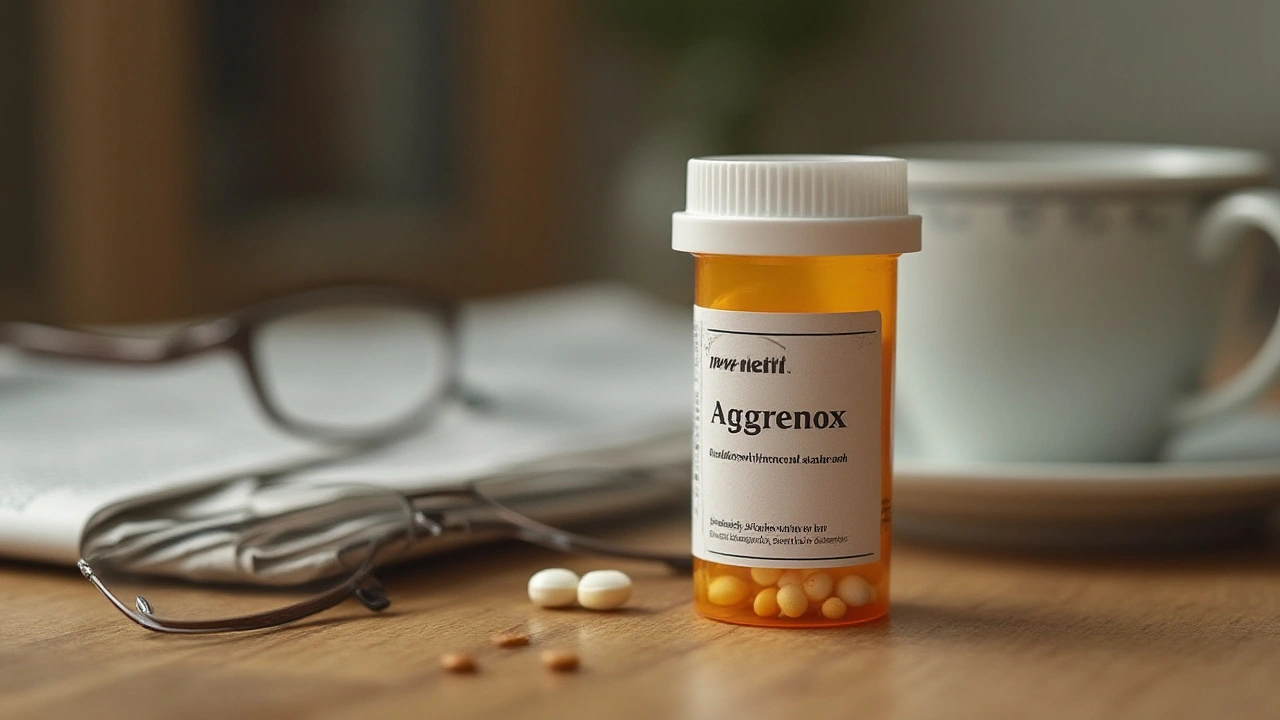Ever wondered why doctors mix two drugs together when one could do the trick? That’s where Aggrenox jumps in—a combo pill that’s more than the sum of its parts when it comes to stopping strokes. You probably know someone, maybe an uncle or a neighbor, who’s been handed this odd-sounding medicine and told to take it after a scary health scare. What most folks don’t realize is how Aggrenox actually works under the hood, what makes it unique, and why it’s not just another regular blood thinner. People are also often blindsided by side effects, or unclear on whether Aggrenox is the right move after a minor stroke or a TIA (that’s a 'mini-stroke,' if you ever heard the term in a hospital waiting room).
Let’s pull apart what makes Aggrenox tick, and why it’s such a mainstay in neurologists’ offices. Anyone facing possible stroke risks owes it to themselves to know the real facts, best practices, and the nitty-gritty most pharmacies won’t tell you.
What Is Aggrenox and How Does It Work?
Aggrenox isn’t something you grab off the shelf at the local drugstore. Instead, it’s a prescription medication designed for folks who’ve already stared down a stroke or TIA and need backup to avoid another. The twist is that Aggrenox actually packs two active drugs: aspirin (the same stuff in your medicine cabinet) and extended-release dipyridamole. On their own, these would be decent at stopping clots, but scientists decided that together, they’re a force multiplier. The aspirin part stops platelets (those sticky little cells in your blood) from clumping up, while dipyridamole keeps them from activating in the first place.
It’s a one-two punch. Aspirin thins the blood by blocking the formation of thromboxane (which tells platelets to stick together). Meanwhile, dipyridamole increases adenosine levels in the blood, which naturally keeps blood vessels open and adds an extra anti-clotting effect. Back in the 1990s, the big ESPRIT and ESPS2 clinical trials checked if this combo beat aspirin alone. The difference, while not dramatic, was statistically relevant—Aggrenox users slashed their risk of another stroke by about 22% compared to just using aspirin. Neurologists like that kind of number, especially for patients who are high risk.
Aggrenox is usually prescribed as a capsule, dosed twice a day. That makes it easier for people who forget midday pills or have trouble dividing up a schedule. It’s not meant for everyday pain or headaches—Aggrenox is specialized, and you’ll only find it used for secondary stroke prevention. That’s a key distinction, because if you take it wrongly or mix it with the wrong meds (say, ibuprofen or another blood thinner), things can go sideways fast.
| Component | Dosage | Main Purpose |
|---|---|---|
| Aspirin | 25 mg | Anti-platelet, stops clots |
| Extended-release Dipyridamole | 200 mg | Keeps platelets inactive, widens vessels |
If you or someone you care about is juggling other heart meds, or dealing with issues like peptic ulcers or asthma, you’ll want to talk with a doctor before jumping on Aggrenox. It interacts with several drugs. And if you’re pregnant or planning to be (like my brother’s wife was when she had her TIA last year), Aggrenox usually isn’t the go-to. Doctors will weigh risks and alternatives.
One thing I always found interesting: In places like Japan and Europe, dipyridamole is much more popular as a solo drug, but in North America, it’s less common outside of this combo. If you need to switch to something else, ask your doctor if you could just take a standard baby aspirin. For many lower-risk folks, that’s what they use—Aggrenox is for people who’ve already been smacked by a warning stroke or TIA and can’t chance a repeat.

Side Effects, Health Risks, and Aggrenox Safety Tips
Now for the not-so-fun part: side effects. This is where most people start to ask serious questions. Since Aggrenox adds up the effects of both aspirin and dipyridamole, you get a little double-whammy. Headaches are absolutely the most common gripe; in fact, about 40% of users experience them in the first week or so. Some people tough it out—my friend Joe swore his headaches vanished after a month—but for a few, they stick around and are so bad they switch meds. If the headaches won’t quit or they mess with your daily life, doctors can sometimes adjust the dose or time of day to help.
Aggrenox can also upset your stomach, so you’re better off taking it with food. Some folks notice nausea, heartburn, or even diarrhea. The aspirin part can make bleeding more likely, especially if you’re prone to nosebleeds or easy bruising. If you see blood in your urine, stools, or when you brush your teeth, don’t just ignore it—get in touch with your doctor, pronto.
The riskiest side effect is probably bleeding in the stomach or brain. It's rare, but the statistics don’t lie. That’s why Aggrenox is never used for people with active ulcers or recent brain bleeds. And, since aspirin can trigger asthma attacks in sensitive people, it’s a non-starter for asthmatics too. You’d be surprised how many folks just assume all blood thinners are interchangeable—definitely not true. Always check your entire medication list with your doctor or pharmacist, because Aggrenox can bump up the effects of anticoagulants (warfarin, apixaban, and so on), blood pressure meds, even some diabetes drugs.
Here are some tips that come straight from real-life experience (and a few close calls):
- Always swallow the capsule whole—don’t chew or crush it. Doing so can wreck the extended-release magic and give you a big dose at once.
- If you miss a dose, just skip it. Doubling up later can lead to serious bleeding.
- If you’re scheduled for surgery or dental work, flag your use of Aggrenox early. Your care team might ask you to stop it a few days ahead of time.
- Keep an eye out for unexplained bruises, red or dark urine, or tarry stools—these can mean internal bleeding.
- Stay hydrated, eat balanced meals, and avoid alcohol binges. Dehydration and booze up your risk of side effects.
| Common Side Effect | Approximate % of Users |
|---|---|
| Headache | 40% |
| Stomach upset | 18% |
| Bleeding (minor) | 10% |
| Dizziness | 8% |
Long-term safety? If you’re tolerating Aggrenox after the first few months, most people do just fine. There have been some isolated reports of liver problems, so if you pick up signs like yellowed skin or eyes, call your doctor. I had one reader last year who forgot he was on Aggrenox and stacked it with a high-dose over-the-counter NSAID for back pain—a combo that landed him with a serious GI bleed. Put simply: always ask before mixing drugs, even for colds or random joint aches.
Aggrenox isn’t usually prescribed forever. Most doctors recommend it for two to three years after a stroke or TIA, but some patients with lots of risk factors might stay on it longer. If you ever need to stop it, don’t go cold turkey without medical advice—stopping suddenly can bounce your clotting risk back up. Gradual tapers work better for some people.

Real-World Use: What You Should Know Before Taking Aggrenox
Before jumping on Aggrenox, set some expectations and make a game plan with your doctor. The medicine isn’t a magic shield; it moves the odds in your favor, but lifestyle tweaks matter, too. Good sleep, blood pressure control, and not lighting up cigarettes make a bigger difference than any pill. I’ve seen way too many folks—friends, even my own stubborn mother-in-law—assume Aggrenox means they can go back to late-night snacks and skipping walks. The pill is backup, not a free pass.
Your doctor should walk you through a risk-benefit calculus. Is your risk of stroke in the next few years above average? Did you have an actual clot, or are you just high risk? For people who had a TIA and also have diabetes, high cholesterol, or atrial fibrillation, Aggrenox often makes sense. But if you’re low-risk, aspirin alone may be enough. The big selling point in the medical world is that Aggrenox hits two clotting systems with one knock, and for some, that’s worth the extra side effects.
Insurance is another twist. Aggrenox isn’t always cheap. Some plans need ‘prior authorization,’ which means paperwork and phone time. Generic versions are available, but occasionally there are shortages—last winter, Theresa had to drive across three towns just to pick it up for her elderly aunt.
Here are some practical must-knows I’ve learned (sometimes the hard way):
- Don’t stop the medicine 'just to see what happens'. If you want to come off it, talk to your doctor and map out a plan.
- Avoid high-intensity contact sports; one weird fall and clot-busting drugs can turn bruises into a bigger ordeal.
- If you get a new prescription—especially painkillers or antibiotics—double-check with the pharmacist for cross-reactions.
- Tell family, friends, and caregivers that you’re taking Aggrenox. If you fall or seem confused, they need to know about your medicine in case of emergency.
- If you forget a dose, don’t panic—just go back to your usual time. Avoid double-dosing at all costs.
Aggrenox isn’t safe if you’re pregnant, under age 18, or allergic to aspirin or NSAIDs. If you’ve got rare enzyme deficiencies (like G6PD), liver issues, or a history of severe ulcers, your doctor will likely look for an alternative. The medicine can also interact with herbal supplements—fish oil, ginkgo, garlic—so bring all your bottles to every appointment. Don’t be shy; your doctor probably sees stranger things every week.
The bottom line? Aggrenox is a solid choice for secondary stroke prevention, with benefits that edge out basic aspirin in head-to-head studies. But it does come with headaches—literally and figuratively—so staying engaged, reading about your meds, and being proactive about side effects will get you the best results. If you ever have doubts, ask until you’re satisfied. There’s no dumb questions when it comes to your brain or your heart.

